The project "wintering birds of our region." active participation in the project. -Filling of birds with children for a walk
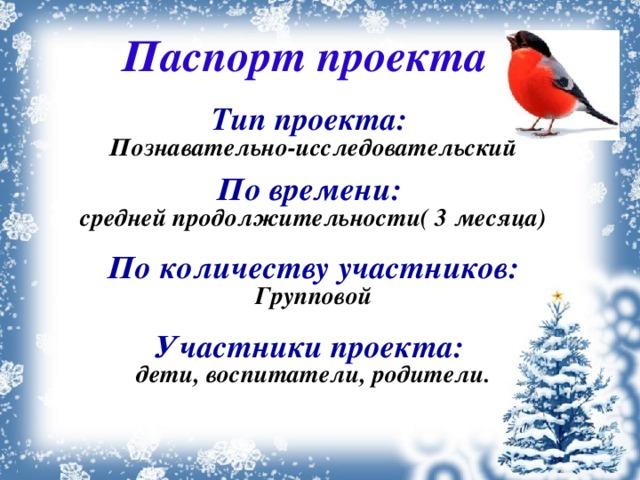
PRESENTATION "WINTER BIRDS" Compiled by: tutor of the middle group "Chernichka" Eglitis K.Ch. Objective: To arouse interest in the surrounding world, to form an idea of wildlife. Objectives: * To give children an idea of the types of wintering birds. * To fix the concept of "wintering" birds * Expand the children's knowledge and understanding of the features of the appearance, habits of birds and their adaptation to the habitat. * Enrich vocabulary, develop coherent speech in children: * Teach children to give full answers to questions. * Intensify the attention and memory of children, develop logical thinking (compare, analyze, make generalizations. We set feeders for birds Pour feed in them And sing pichugi in flocks: "Hello, Zimushka-Winter! Wintering birds do not fly away from us to warm countries. They feed on kidneys, seeds, fruits of trees and shrubs. They search for food near a human being. Often, in winter, birds die from hunger, therefore, in winter, birds need to be fed. I catch bugs all day, Tuck up worms. Chick - tweet! Do not be shy! I am experienced ........ The Sparrow is a small, brisk bird. People often say about him: "The gray sparrow". But in fact the sparrow is not gray at all. The back, the tail is brown with black stripes. brown, decorated with red stripes, breast gray Chin black Head - brown. Sparrows live in the city and in the village, they are well adapted to people's habits Sparrows love to live among people because they are protected from predators, they have food, and secluded places where You can make a spring nest. City sparrows make their nests under the visors of the porch or balcony. Fizkultminutka: "Sparrow" Among the white doves, a nimble sparrow jumps. Sparrow - bird, Gray shirt. Respond, sparrow, Take off, don't be shy. They wear a gray vest, And at the wings - black color Twenty pairs immediately turn around. Everyone shouts: Kar! Kar! Kar! Kar! Let's look at the crow. This is a large bird, it does not stand out in bright colors. The head, throat, wings, tail, and paws of a crow are black. Big black beak at the crow. And everything else is gray. The crow is very cunning, agile bird. She is well adapted to live with people. Crows love to live in big cities. About one million crows winters in our city. The crows are omnivores and can often be seen at the garbage cans and in landfills. Crows like to gossip. They like to tease dogs: They will sit on a branch and bark loudly. “Woof! Woof !. The dog barks and the crow crows. With the onset of spring, the crows begin to gather on the way. They fly away from the city to groves and forests, and there they build large nests on the trees in the bushes that are covered with fluff, dry grass and feathers from the inside. Crow eggs are colored bluish. Soon there are very voracious chicks - ravens. Finger gymnastics: How many birds came to our manger? We will tell. Two tits, a sparrow, Six goldfinches and pigeons, a Woodpecker in motley feathers. All had enough pips. The snow covered all the paths. I rested at the Osinki. Suddenly a bird sat on a branch, In a yellow dress ...… Sinichka is a small bird with a bright and beautiful plumage. It seems that the titmouse dressed in a bright yellow with a black tie and a green raincoat, and adorned the head with a dark hat. The titmouse is interested in everything, everywhere curious beak is thrusting everywhere, it does not sit still for a minute. On a clear March day, it seems that the bells are tinkling softly somewhere. It tits titmouses. Birds are happy sunny day. They chirp: "Blue-blue-blue!" In the spring of blue tit looking for a place to nest. Sometimes they occupy old woodpecker's nests, and if they don’t find their own ones. Soon in the nest hidden in the branches of trees 15-17 eggs will appear. And after a while the chicks hatch. The titmouse works hard: they catch mosquitoes, midges, caterpillars, aphids and feed numerous chicks. In the summer in the forest a lot of food and titmouse make stocks not only for themselves, but for the whole tribe. Despite this winter titmouse need to feed. QUIZ IN WHICH BIRD OF BLUE EGG EGGS? The game "Find by description" A little bird with a beautiful feather? end
The partial axis of the egg is aligned with the axis of this angle. Each pollen is characterized by the ratio of pollen to the diameter of the egg. These pairs of indexes are the basis for finding an oval patch in a specially designed table. During the hunting season, 75 species of birds were found, of which 7 dominant species made up about 55% of the population. During the winter period, 39 species of birds were found, of which 4 dominant species made up 64% of the population. The proportion of hollow species was 41%.
Together, during 2 nesting seasons, 39 nesting birds were found on the square. Outside the research area in the west, 10 species were found. The value of the Diversity Index has reached an average of 3, 82, and the equity index is 0. Of these, 68 species of water and wetlands, 89 nests, 46 hospices and 36 migrants. The types of water and wetlands were also analyzed. In the work of groups, species are discussed as bioindicators of the state of biodiversity conservation of a similar nature.
MBOU « Polevo Lyceum »
Kursk district of Kursk region
preparatory group
preschool education
Ecological project
“Feed the birds in the winter!”

Project Passport
Project Type:
These are the factors and characteristics of individual streams that can increase the biodiversity of the streams. On the territory of the Republic, seven species of herbivorous species and one species of ibic birds were identified. Of these species, only Heron White did not drift in the area. The most famous colony of Czech beetles in the Republic of the Czech Republic in the park of the Lednice gardens is stable in recent decades. He regularly spends around 250 quaint nights, which is two-thirds of all the royal islands in the Czech Republic and the same number of cousins.
Cognitive-research
By time:
average duration (3 months)
By the number of participants:
Group
Project participants:
children, educators, parents.
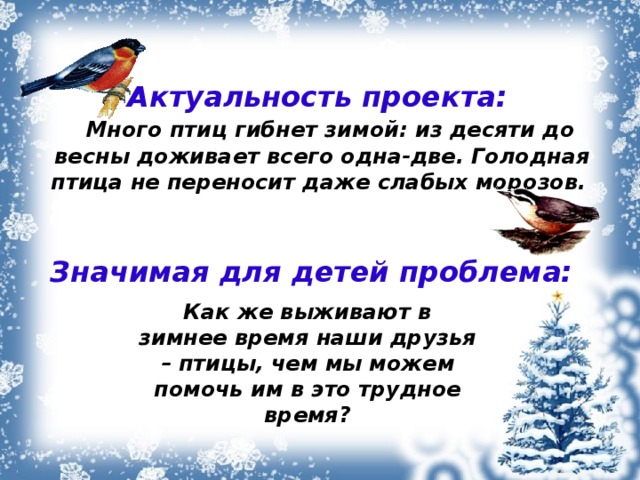
Relevance of the project: Many birds die in the winter: out of ten to spring only one or two survive. A hungry bird does not tolerate even frosts.
The strongest of them was a small buckwheat population. Other species, beech, large, red heron, scarlet heron, and white foal nest irregularly in the study area. The paper also reflects changes in the number of species observed, depending on changes in the country.
A total of 302 registered cormorant hunts were most observed among fishmen in Studinek. The presence or absence of cormorants in fish ponds was influenced by the size of the ponds and the distance from the night, the statistical significance of which was related to the fact that the distance from the night and the structure of the fishermen were statistically significant.
Important problem for children:
How do our friends survive in the winter - birds, how can we help them in this difficult time?
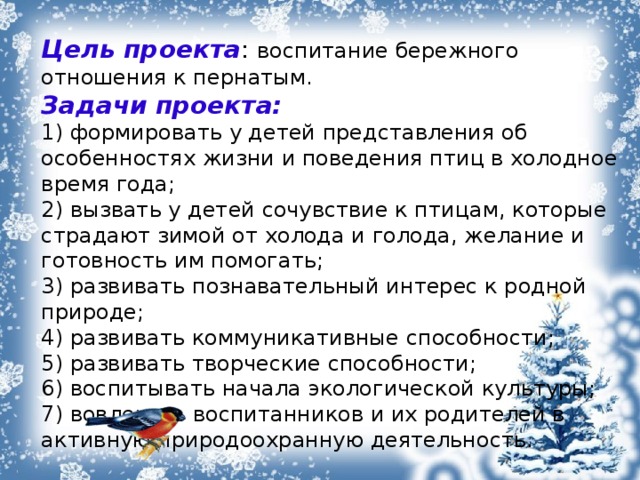
Objective of the project : nurture respect for feathered.
Project tasks:
1) to form in children ideas about the characteristics of the life and behavior of birds in the cold season;
Nightly counts were highest in March, July and September. During this period, 17 settlements were found, and 71 observations of splashed water were made. Random birds were found in two types of environments - in the days of ponds and ponds. The number of birds in some winters ranged from 1 to 7 years. and correlates positively with the average winter temperature. The number of birds found in each observation was related to the average temperature of a decade. The connection between the numbers of birds and the winter type is not established.
At present, more than 12 species from 4-7 species are represented in Europe. The situation is similar in other parts of Central Europe. In addition to these invasive manifestations, the seven-time gull occurs on the territory of the Republic, although regularly, but in small quantities. Most of the people found appear in the late autumn and winter months. In adult and adult birds there is a decline. They are mainly covered by the autumn shift, with adult outbreaks likely to affect extreme climatic conditions.
2) cause in children sympathy for birds that suffer from cold and hunger in winter, desire and readiness to help them;
3) develop a cognitive interest in native nature;
4) to develop communication skills;
5) develop creative abilities;
6) to bring up the beginnings of ecological culture;
7) to involve pupils and their parents in active conservation activities.
The maximum observed birds moved in November. Some birds may be in the same place for several weeks. Discovered people often experience an inability to fly, and many of them die. The workplace made recommendations on the publication of observed observations of this type.
Parental investments in offspring are the subject of research in many recent studies. A number of factors that are often not controlled can influence the behavior of parents. This study presents the results of a study of the behavior of herbivorous lines. The eating of the laundry was very variable, much of this variability was due to several factors, such as parent, old and day. Men and women were guided by their various feeding strategies, and their strategies also changed in the light of day and age.


Stage I - preparatory
1. The study of methodological material on the implementation of environmental actions in preschool.
2. Determination of the content, forms and methods of work organization.
The results indicate, among other things, the importance of monitoring these factors, especially for comparative studies of food production. Address: Faculty of Science, University of Palacky, Department of Zoology. Lindukov avoided the edges of the meadows during the selection.
One explanation of this behavior may be the reaction of birds to the increased risk of predator hunting in this biotope. The beginning of transportation falls on the May decades and depends on the flight time. The average snack size was 6, 00 eggs, respectively. 6. 15 eggs. The number of animals harvested was 5, 48 per one nest, and the success rate found by the traditional method was 68%, by the Mayfield method - 35%. There was an accusation that a woman was taken from a stallion for a purse. The fate of the fool is unknown, and this is probably a replacement.
3. Selection of fiction, didactic games, electronic presentations
4. Creating a wall newspaper for parents “Feed the birds in winter! ". Placing in the information corner of the wall newspaper appeals to parents and children to take an active part in the project.
Stage II - the main
Work with parents:
Polygamy was performed by one of the men. Among males of the garden and household, both aggressive behavior, including contact battles in the air and on the ground, was often observed as on holidays. A few days later, her mother’s mother fed only the abundant mother of her garden, but her own father — the male garden rehek never fed them. Later, she was noticed by a woman-boy in the garden against a male river-house, which was attributed to 2 m to her pier. During the feeding period, it was observed by the male river, which was 15 meters from its nest in its food area against the saccharide river, which violated the territorial border.
-Placing booklets "Help the birds! "
Work with children:
- “Wintering birds”;
5 ) Didactic games .
6) Dialogue games .
8) Productive activity.
Stage II - the main
Work with parents:
-A call to participate in the environmental campaign "Feed the birds in winter!" ";
To motivate children in the activities that will be deployed during the day, the following scenario will be presented: As the open circle unfolds, the person who brings the letter appears. He conveyed the news to the hot countries that you are very smart, you know how and feel good.
But on the way from warm countries to Romania, we need to pass several tests. We are small, and we ask you to help us accomplish the tasks we receive in order to get there as soon as possible. Objective: Communicate children through semi-disciplined activities that accumulate accumulated knowledge and prepare the following activities.
-Participation in the contest "Best Feeder"
-Production of bird feeders together with children;
-Filling of birds with children for a walk;
Work with children:
1) The cycle of classes to get acquainted with the world of nature. “Little Birds”;
- “Wintering birds”;
2) Reading fiction.
Methods: conversation, explanation, demonstration, play, storytelling, problem solving; Means: colored pencils, patterns, scissors, tokens, puzzles, chips. He gathered from the “Seasons” parade, p. 110. Funny Long legs are rising. He runs over the pond.
Mandra as a little girl with a tail, like a fork. Didactic scientific event Event Earn the team that has accumulated the most. Methods of didactic methods: means. Presentation of the content and directions of training. Dialogue Demonstration Explanation.
Correctly answers the riddle. Formulate a mystery about birds. The representative of the opposite team indicates the number of words in the sentence and records the number corresponding to the number of words. This will be the same as the other team. Say a stamp from poetry with traveling birds or the season in which we are. Link Purpose: To distinguish between sound from the environment and musical sounds. Operational objectives: to distinguish sounds from the environment from the source that it produces. Observe the correct tilt position for proper sound emission; To sing correctly and expressively the song “In the Green Forest”, observing rhythm, intonation and measure; Affective goal: to cultivate a love of art, implicitly to music.
4) Cycle bird watching for a walk.
5 ) Didactic games .
6) Dialogue games .
7) Mobile and finger games.
8) Productive activity.
9) consideration of reproductions, illustrations, albums "Wintering Birds";
10) viewing the multimedia presentations “Wintering Birds”.
Every day they tweet, and the bobbits giggle. Transition: we will tell some words: On the birds about which we spoke. And we all started. No Didactic events Preparing for an event Capturing attention Announcement of topics and tasks. Close your eyes and listen carefully. At M4, my handful of your hands, you open your eyes, and the child will tell you what was heard. The teacher will remember the correct position during the song and intonate the fragment.
The game of the game: children, divided into two teams, are located one after another. There are two eggs on the playing surface: one placed in a basket, in front of the group, and the other in a nest on the edge of the playing surface. The first child takes a spoon, lays an egg into it, walks, crosses an obstacle, crosses a bridge - lays his egg in a nest. After that, he takes another egg and puts it in a spoon. Do the same until all the children in the group have completed the proposed task. Win a team that manages to transport eggs without breaking them.
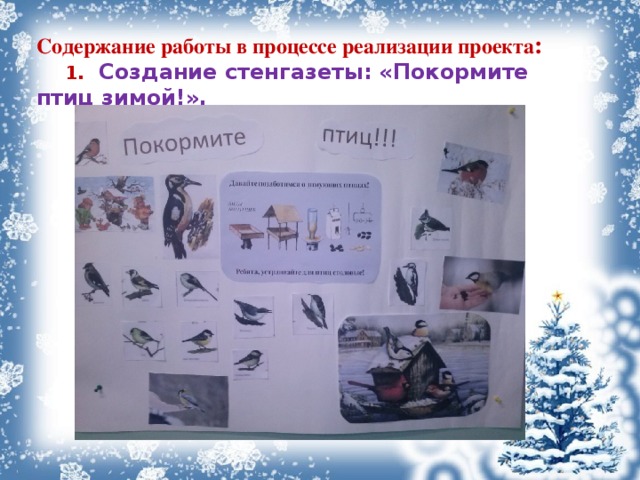
1. Creating a wall newspaper: “Feed the birds in the winter!”.

Children enthusiastically participated
in the design of the wall newspaper.
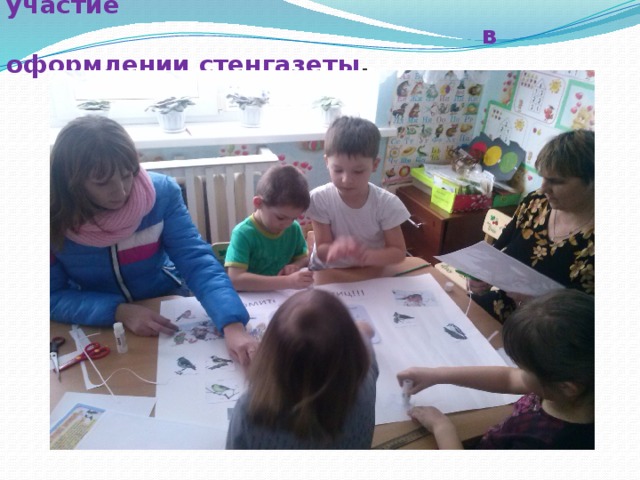
Parents also actively participated.
The child is in the middle of the circle. Rendika in the middle, which does not have a nest, also wants to occupy the nest. A child left without a nest passes in the middle of the circle. Also organized this year a census of waterfowl in Romania. Thus, 57 people took part in the event. Observers collected data from 146 locations in 25 districts. Most of the sites visited were located in Bihor district, and then in Arad district and Mures district, but the scale and area of the studied objects were very different. Wetlands with small areas such as lakes and smaller rivers were visited in these counties.
in the design of the wall newspaper .
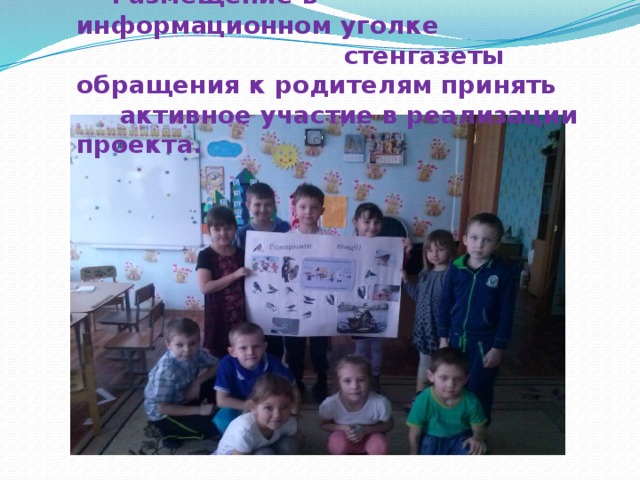
Placement in the information corner of the wall newspaper addressing parents to accept
active participation in the project.

2. Competition: “Feeder for birds”.
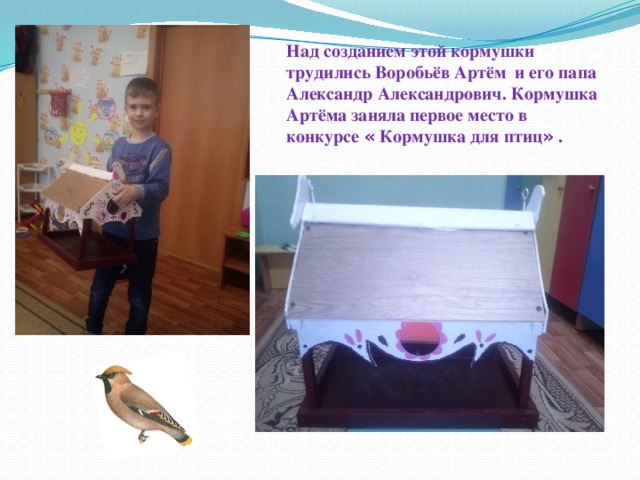
On the creation of this trough worked Vorobev Artem and his father Alexander Alexandrovich. Feeding trough Artem took first place in the competition « Bird feeders » .
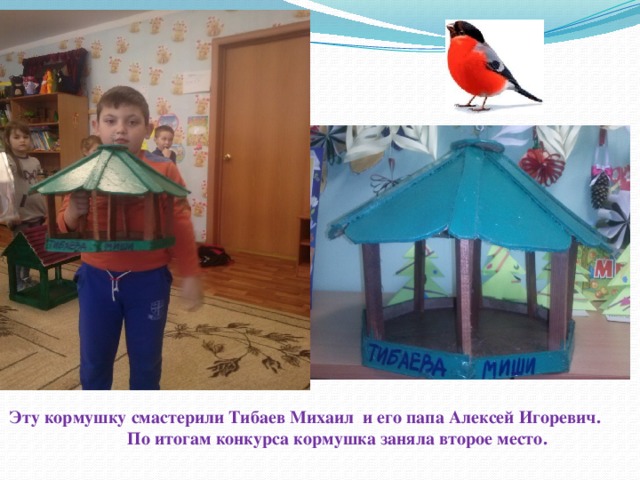
This trough was made by Mikhail Tibaev and his father Alexey Igorevich.
According to the results of the competition, the feeder took the second place.

Kharskaya Sofia and her father Sergey Anatolyevich worked on the creation of this trough. . Feeding trough ranked third in the competition "Feeder for birds."
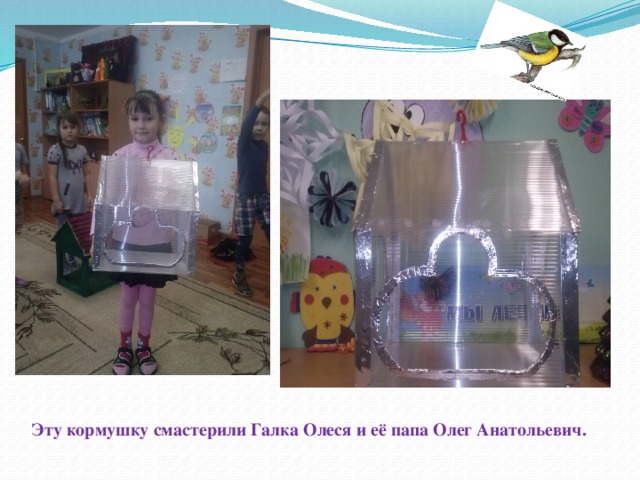
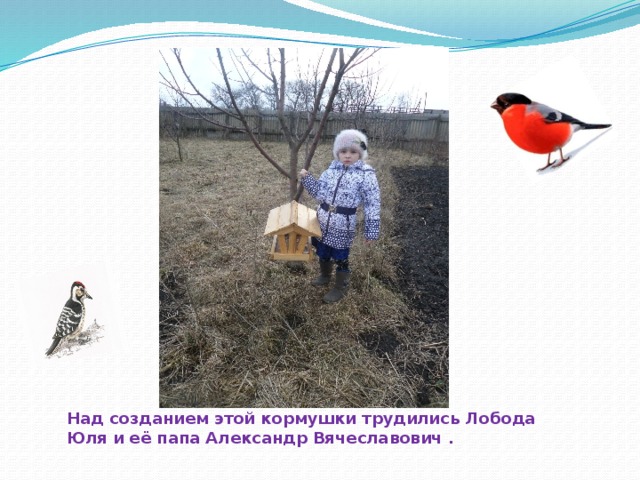
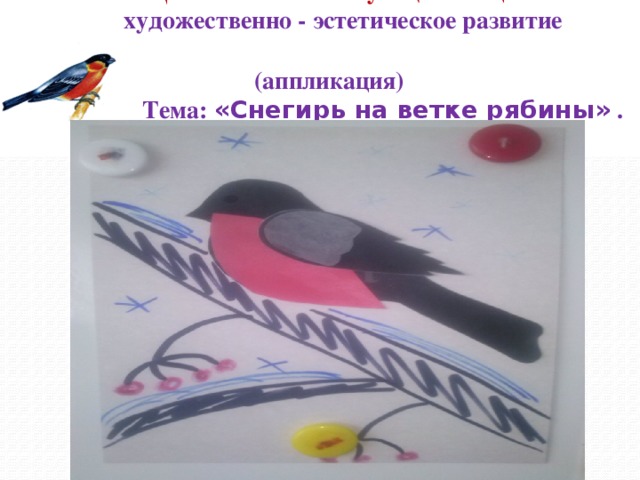
3. The cycle of lessons "Wintering birds"
(application)
Theme: « Bullfinch on a mountain ash branch " .

artistic and aesthetic development
(drawing)
Subject: "Which birds flew to the trough."
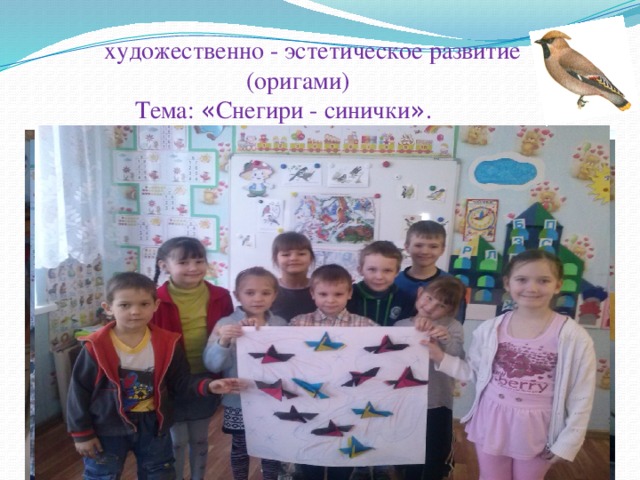
artistic - aesthetic development
(origami)
Theme: "Bullfinches - titmouses".
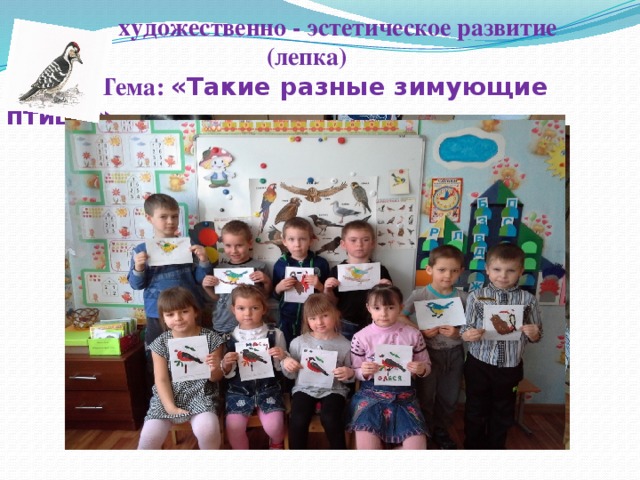
artistic - aesthetic development
(modeling)
Theme: « Such different wintering birds » .
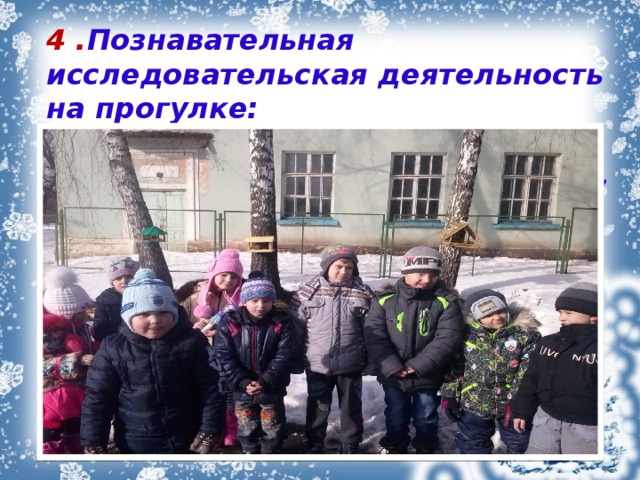
4 . Cognitive research activities on a walk:
“Feed the birds in winter”
Goals: 1. To teach children to distinguish birds by plumage, size, habits.
2. Develop observation, memory, speech; develop movement, agility, quick response, action on a signal.
3. Foster an emotionally positive attitude towards birds; kindness, hard work. responsiveness, desire to help and do good deeds.
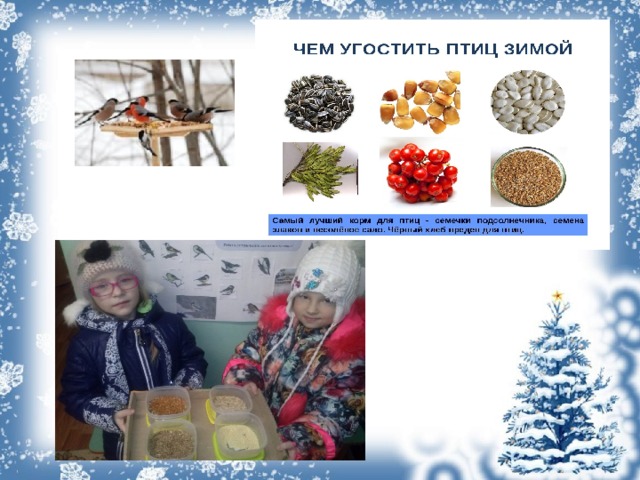
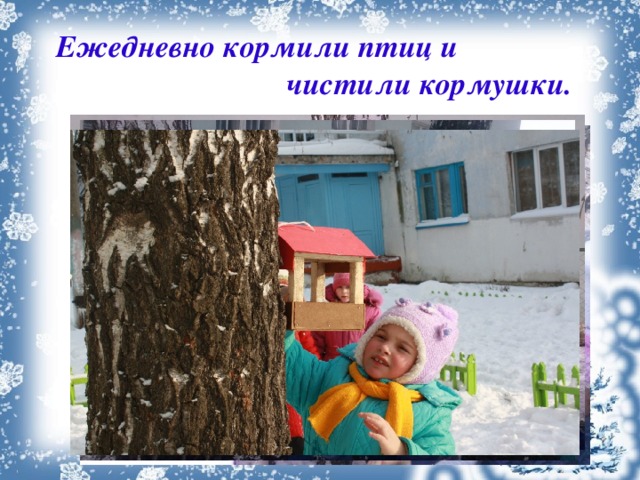

Bird watching:
here in December flew woodpecker and blue tit.
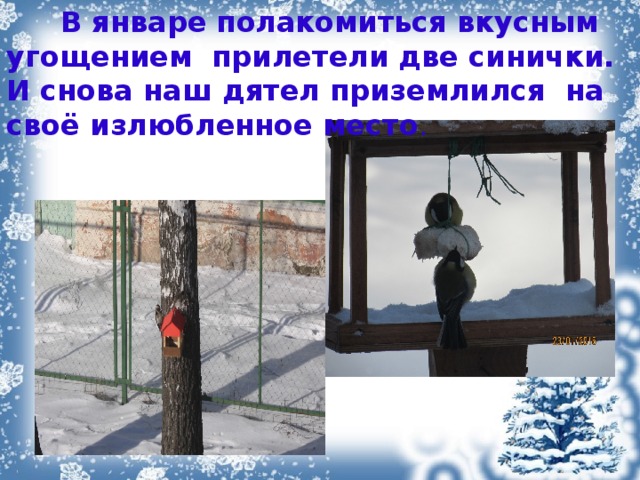
In January, two titmouses flew in to enjoy a delicious treat. And again our woodpecker landed on his favorite place.

Gaming activities
Outdoor games : “Eagle owl and little birds”, “Sovushka”, “Birdies”, physical exercises, exercises for developing hand motor skills.
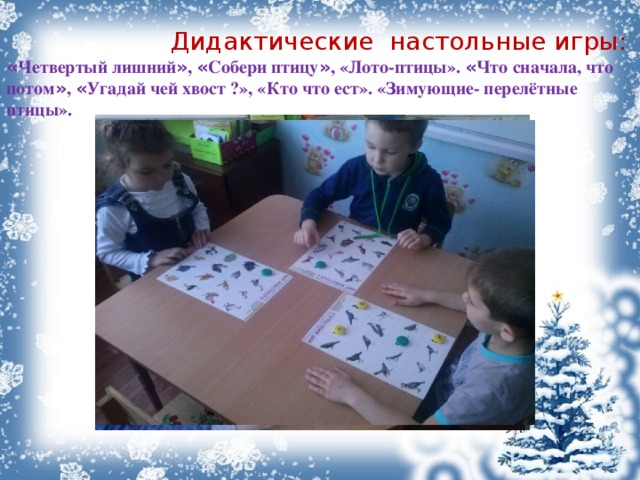
Didactic board games:
« Fourth extra » , « Collect the bird » , "Bingo-birds." « What first, then what » , « Guess whose tail? ”,“ Who eats what. ” "Wintering - migratory birds."

Familiarization with fiction:
Reading stories - V. Bianki “Sinichkin calendar”, A. Barto “Crows”, G. Boyko “Fly under the window”, N. Sladkov “The Magic Shelf”, “A Piece of Bread”, V. Bianki “The Crazy Bird”, G. Skrebitsky and V. Chaplin “What a Woodpecker Feeds on in Winter”, “Winter Guests”, learning a poem “Feed the Birds in Winter! ",
A. Prokofiev “Bullfinch”, N. Rubtsov “Sparrow”, viewing presentations: Wintering Birds ”,“ Feeders ”, Discussion of proverbs, sayings, guessing riddles, viewing illustrations depicting wintering birds.
Stage III - Final
- Registration of the result of the project in the form of a presentation.
- Making mini projects "Wintering Bird".
- Performance analysis of the project.
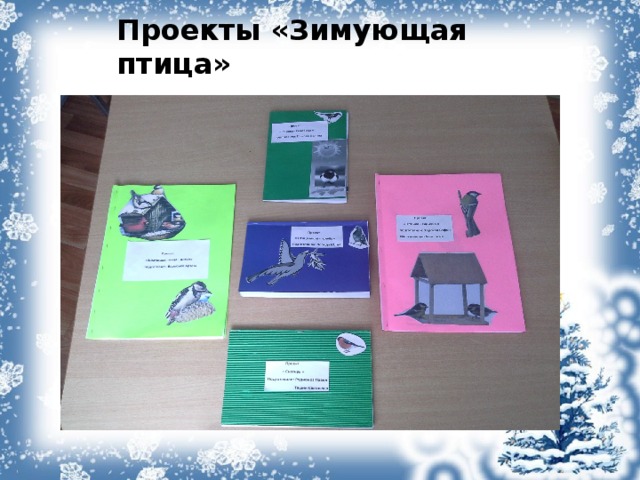
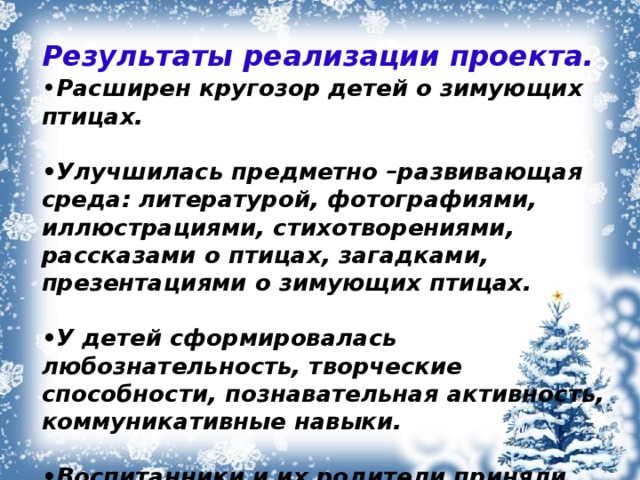
The results of the project.
The children's outlook on wintering birds has been expanded.
The subject-developing environment has improved: literature, photographs, illustrations, poems, stories about birds, riddles, and presentations about wintering birds.
Children developed curiosity, creativity, cognitive activity, communication skills.
Pupils and their parents took an active part in helping birds in difficult winter conditions.
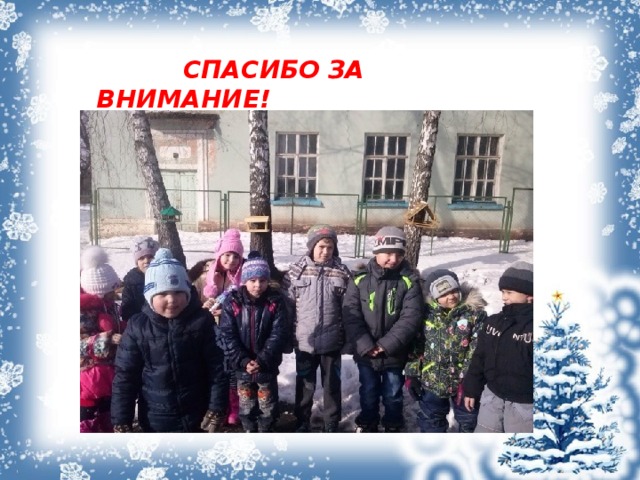
THANK FOR ATTENTION!
- Home decor for the new year
- Summary of literacy classes for children of the preparatory to school group "Sound and the letter Y"
- Voicing consonants: examples
- Algorithm for solving the ege on the Russian language
- · · Speech therapy commission in children
- Lexical theme: "Animals of hot countries"
- Recommendations for the development of coherent speech in preschool children

 Live journal
Live journal Facebook
Facebook Twitter
Twitter